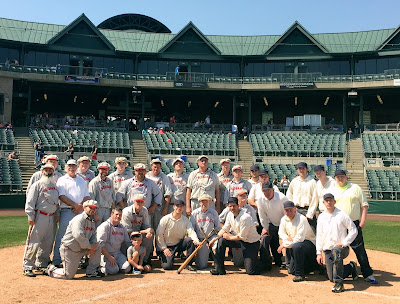As I would think is the case with most universities, the 50th is the most significant of all Rutgers reunions including induction into the "Old Guard" on Friday night, a milestone event. During the evening the glee club will perform school songs, one of which proclaims Rutgers to be "Ever changing, yet eternally the same." Considering almost anything as eternal is more than a little bit of a reach, but it's not a totally inappropriate way to look at this reunion. Fifty years ago when my class graduated, wondering what impact the Vietnam War would have on us, the Class of 1918 was celebrating their 50th reunion. That class of just 42 men graduated a century ago, harboring even greater concerns about World War I, not knowing the war was almost over. And when the 1918 class bid farewell to Old Queens, the Class of 1868, all 36 of them, experienced the 50th anniversary of their graduation which took place in a country still recovering from the Civil War. I'm not sure about how early reunions started, but in 1868, the Class of 1818 could have held their 50th reunion in a phone booth (if phones and phone booths had been invented) since there were only two of them. While 200 years isn't eternal, on a relative basis it's not bad.
While there isn't any news this week from the vintage base ball field, there is some very satisfying news on the book front. Earlier this week I received an email from noted baseball historian Steve Steinberg that The World Series in the Deadball Era will be published on April 30th. Steve has done more than yeoman's service in bringing this project to fruition and I'm very much looking forward to the finished product to which I've contributed two chapters, one with Paul Zinn. The key word here is contributed since other than providing context, neither Paul nor I wrote a word of either chapter. The inspired idea behind this book was to follow the model of G. H. Fleming's classic work - The Unforgettable Season. Originally published in 1981, Fleming told the story of the epic 1908 National League pennant race through the words of the contemporary sportswriters who saw that historic season unfold before their very eyes. Three clubs, the Giants, Cubs and Pirates battled for the pennant not only down to, but past the end of the regular season. Any close, winner take all pennant race is fascinating, but the story of the 1908 race hinges on the controversial Merkle play, a base running blunder by rookie Fred Merkle of the Giants that forced the Cubs and Giants to play a make up game after the regular season had ended. It was Mordecai "Three Finger" Brown's account of how Chicago won the game and the pennant that got me permanently hooked on baseball history some 60 years ago.
Mordecai Brown - left 1909, right 1916
The idea in this case is to tell the story of each of the World Series (or World's Series as it was called at the time) of the Deadball Era (1903-1919) in the same fashion. Since Paul Zinn and I literally wrote the book about the 1916 pennant races, it was only natural for us to take that year's fall classic which we completed without any major obstacles. Some time after that I learned that two or three other series were available including the last one of the period, the 1919 series, famous, or more accurately infamous for what is known to history as the Black Sox scandal. I took advantage of that opportunity which involved a lot more research than just reading the contemporary game accounts. My motivation was curiosity about whether the sports writers of the day had any sense something untoward was going on. Probably not surprisingly the game accounts don't give a clear cut answer so anyone who shares my curiosity needs to read the book and draw their own conclusions. The book is expensive, but these eyewitness accounts of the birth of the modern World Series along with some 250 pictures make it well worth the price. Among other things it's a very appropriate Father's Day present for any baseball fan.










